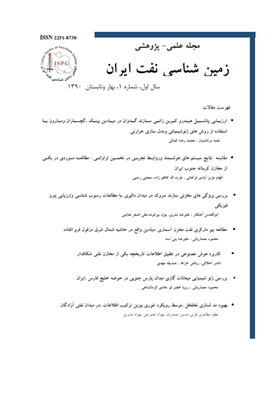مطالعه بیو مارکری نفت مخزن اسماری ،میادین واقع در حاشیه شمال شر دزفول فرو افتاده
محورهای موضوعی :محمود معماریانی 1 , علیرضا بنی اسد 2
1 - پژوهشگاه صنعت نفت
2 - دانشگاه تهران
کلید واژه: فرو افتادگی دزفول آسماری میادین حاشیه شرقی کروماتو گرافی گازی کروماتو گرافی گازی –طیف سنجی جرمی سیستم های نفت ,
چکیده مقاله :
میادین مسجد سلیمان ،هفتکل ،پر سیاه ونفت سفید ،از میادین تولیدی هستند که در حاشیه جبهه کوهستانی شمال شرقی فرو افتادگی دزفول قرار دارند .در این کار تحقیقیاتی به منظور تطابق ژئو شیمیائی وتعیین سیستم های نفتی مخزن آسماری میادین مذکور ،نمونه های نفتی از این میادین بوسیله تکنیک های کروماتو گرافی گازی وکرو ماتو گرافی گازی –طیف سنجی جرمی مورد مطالعات بیو مارکری قرار گرفته است .بررسی نتایج نشان بدست آمده از مطالعات بیو مارکری نمونه های نفتی نشان دهنده وجود دو سیستم نفتی احتمالی در این منطقه می باشد ،یک سیستم نفتی اصلی که تولید ،مهاجرت وانباشت هیدرو کربن در هر چهار میدان را تحت کنترل داشته است ویک سیستم نفتی فرعی که اختلاط نفت در میادین پرسیاه ومسجد سلیمان را با منشاء دیگر باعث شده است .پارامتر های مختلف بیو مارکریهای هوپانی ،استرانی،مقادیر پریستان به فیتان وهمچنین آلکان های نرمال بیانگر تولید این نفت ها از سنگ منشاء دریائی کربناته وکربناته کلاستیک در یک محیط احیائی می باشند ،نوع کروژن تولید کننده نفت از نوع II با مشارکت اندکی از نوع کروژن III بوده ونفت ها دارای بلوغی در حد اوایل پنجره نفت زائی وعدم تحمل پدیده دگر سائی شدید می باشند .توزیع ایزو توپ 13C وحضور بیو مارکراولینان در نفت مخزن آسماری میادین پرسیاه ومسجدسلیمان واندک تفاوت ها عمدتاً در لیتو لوژی ومیزان بلوغ –احتمالاً ناشی از اختلاط نفت ها از دو سنگ منشاء می باشد. سازند پابده (ائوسن-الیگوسن )با درجه اهمیت بسیار کمتر از سازند کژدمی (آلبین )که تغذیه کننده اصلی می باشد .
Masjid-e-Solyman, Haft kel, Par-e-Siah and Naft Safid are productive oil fields which are located in mountain front of NE Dezful Embayment. In this research, in order to Geochemical correlation and Petroleum Systems determination of Asmari oils, a few oil samples were subjected to biomarker studies by GC and GC-MS techniques. Review of biomarkers fingerprints indicate two petroleum systems probably are active in studied oilfields. A major petroleum system that has controlled the hydrocarbon generation, migration and accumulation in all studied oilfields and a younger petroleum system, which has caused mixture of oils with another source in Masjed-Soleyman and Par-e-Siah oilfields, Biomarkers fingerprints, Steranes, Hopanes in addition to the main petroleum system. parameters, Pristane to Phytane ratios and also n- alkane's distributions among the studied oils, indicate that the Asamri oils were produced mainly from a marine and marine-carbonate source rock(s), which has been deposited in an anoxic conditions, with kerogen mainly of Type II with little contribution of terrestrial Kerogen (Type III) and oil samples has a maturity about early oil window without any severe biodegradation. 13C isotope values distribution, presence of Oleannane biomarker and slightly differences - mainly from lithological aspects and maturation levels of oils - of Masjid-Soleyman and Par-e-Siah Oils, reveal that, the mixed oils in these two reservoirs have been probably produced from two source rocks, a younger source rock namely Pabdeh Formation (Middle Eocene and Early Oligocene) with less importance of Kazhdumi Formation (Albian) which is the main source rock.


